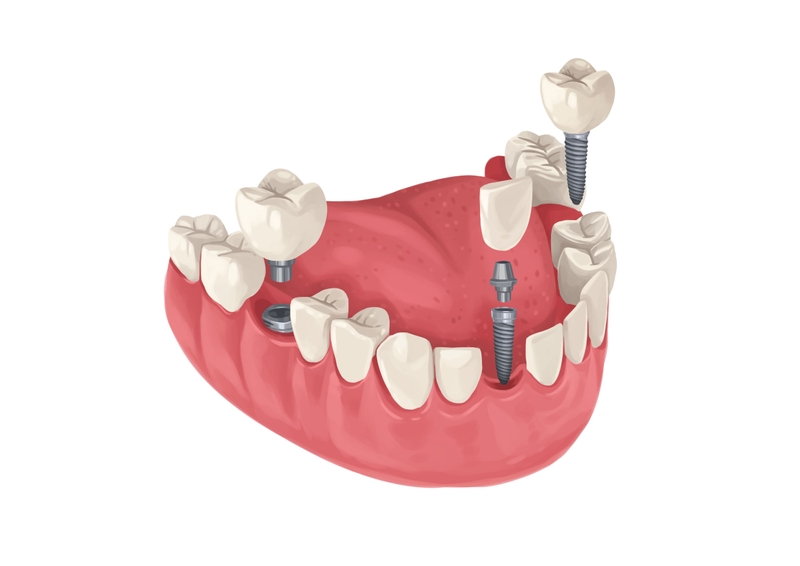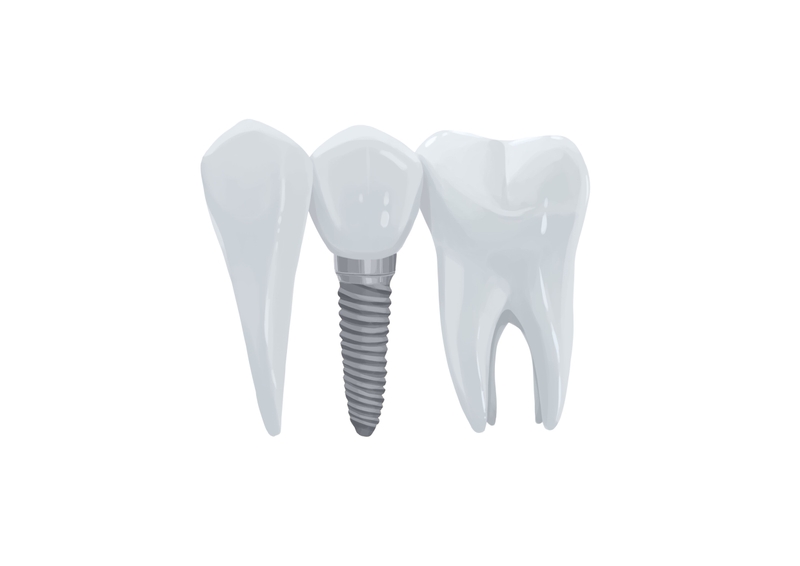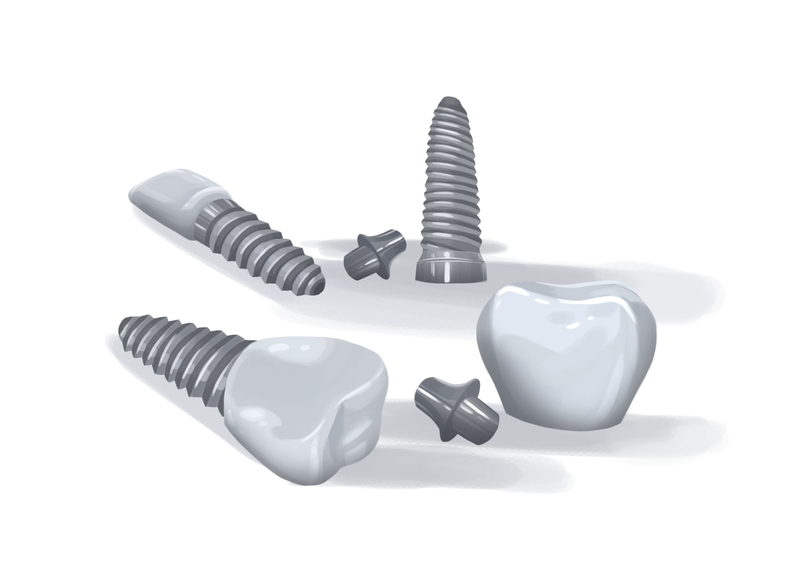- If implantation fails, you may need to remove your implants. Infection, a loose implant, rejection, displacement into a sinus, or interference with facial nerves are some of the causes of failure.
- The procedure for removing dental implants depends on the amount of time the implant has spent in your body.
- The care instructions after removal are similar to the instructions after placement. Depending on your health, you may receive a new implant after removal.
Get a million-dollar smile. Use Authority Dental to book an appointment for dental implants in your city. It's fast, easy and reliable.
What signs point to dental implants removal? Here's everything you need to know.
Causes for removing dental implants

Picture by Authority Dental under CC 2.0 license
Failure is the most common reason for removing dental implants. That is often caused by:
infection,
rejection,
displacement into a sinus, or
impingement on the facial nerves.
The first is patient-oriented chiefly. An infection can happen due to unsatisfactory oral hygiene or smoking. It is extremely rare for an implant to become contaminated due to malpractice or anything during the placement process.
Lee explains: "The primary cause we see years after placement is peri-implantitis—a deep infection caused by poor hygiene and maintenance. This leads to slow, silent bone loss, and once the implant loses enough supporting bone, it becomes loose and has to come out."
"The other common cause is early mechanical failure, usually from overloading a recently placed implant before the bone has fully fused, or trying to put an immediate implant into a site that just wasn't ready," he adds.
If the pressure on the replaced tooth is too enormous, the implant can move. Such a situation is called overloading. This makes proper fusing with the bone more complicated, and the rod can become loose.
The most common reason for implant movement or instability is placing an immediate implant in a patient who is not a good candidate.

Rejection can have several causes. It can happen due to allergies or a medical condition such as:
rheumatoid arthritis,
lupus,
multiple sclerosis,
type 1 diabetes,
uncontrolled type 2 diabetes,
celiac disease,
head and neck cancer (radiation to the jaws), and
trauma.
Those can be contraindications to implant placement in the first place. Your dentist will perform a thorough examination before the procedure to ensure it will not be a problem. That is why rejection is not a common motive for removing an implant.
How to remove dental implants?

Picture by Authority Dental under CC 2.0 license
The dental implant removal procedure depends on how long it has been in your mouth. The goal is to remove the failed implant while extracting as little bone as possible. The methods differ according to whether the failure is considered early or late.
Early failure
An early failure means removing an implant that has not osseointegrated yet. For the patient, the procedure looks very similar to the placement surgery. You will go under anesthesia. The dentist will remove the crown and abutment if they have already been placed. The final step is to extract the rod.
The methods include using instruments similar to those used in extractions. These can be a lever, an elevator, or forceps. Usually, the implant can be unscrewed from the bone.
Early failures can happen within 48 hours after placement. The removal process will be similar for implants that did not integrate with the bone properly and remain loose.
Late failure
Can you remove a dental implant once it has fused with the jawbone? Yes. However, this situation requires more intensive action, which means you might have to be completely sedated.
Choosing the appropriate procedure depends mainly on how much bone remains around the rod. As little as 2-3mm can still hold it firmly.
The most common method is mechanical. An instrument called a trephine bur is used to cut the implant out with a small portion of the bone. High reverse torque can unscrew the implant only if there is not much healthy bone left around it.
A poorly osseointegrated dental implant can also be removed using ultrasonic waves. Such a procedure is called Piezo surgery. It is often performed when implants are fractured or mispositioned. The jawbone can heal better when ultrasonic waves are used rather than a trephine bur.
The third way is using a laser. This method takes longer, but it removes much less bone and causes far fewer microcracks than the first technique.

If you're in pain and need same-day dental implant appointment please call us 24 hours a day. You will get help immediately from a certified dentist.
Post-removal care instructions
Dental implant removal aftercare is similar to the recommendations after the initial placement.
Drink only cold liquids and avoid eating until anesthesia has worn off. Try not to touch the affected area with your tongue or fingers. For the first two days, you should rest rather than exercise or strain yourself otherwise.

The recovery time for dental implant removal is about 5 days. You are likely to experience some pain during this time. Take OTC painkillers to manage that. The most challenging step will be deciding how to go about the missing tooth.
Options after dental implant removal

Picture by Authority Dental under CC 2.0 license
Removed dental implant options include dentures or a new implant. Most cases will require bone grafting, which means a replacement will not be installed until after a couple of months of healing.

A dental implant can be replaced with a new one if the surgical site is free of infection and sufficient bone remains. A course of antibiotics and mechanical cleaning may be undertaken if the area is contaminated.
Dentures are also a standard solution. Your dentist may fit you with a full or partial restoration, depending on the situation in your mouth. The gums and bone may have to heal before such dental work can be performed. If you want your smile fixed quickly, you can go for a dental bridge or a flipper tooth.
FAQ
Is dental implant removal painful?
Are there complications to dental implant removal?
Removing a dental implant is not always a complicated process. The biggest dental implant removal complications are some pain and discomfort. In extreme cases, you may experience bone loss and microcracks in your jawbone.
If removal is necessary, the dentist will review your case to determine what method will cause the least damage
How much does it cost to remove a dental implant?
Dental implant removal cost starts at $500 and tops off at around $1,000.
An early failure will probably cost a little less than a late one. This is because the procedure is less severe. The price might likewise be lower if you have your implant removed in the same office where you had it placed.
Can a new dental implant be placed after the failed one is removed?
References
- Avoiding implant overload
- Methods to Improve Osseointegration of Dental Implants in Low Quality (Type-IV) Bone: An Overview
- Titanium Allergy: A Literature Review
- Removal of failed dental implants revisited: Questions and answers
- Factors associated with early and late failure of dental implants
- Risk factors associated with early failure of dental implants. A literature review
- Risk Factors related to Late Failure of Dental Implant—A Systematic Review of Recent Studies
- Utility of Trephine Drills in Implant Dentistry
- Reverse torque evaluation in indexed and nonindexed abutments of Morse Taper implants in a mechanical fatigue test
- Piezosurgery applied to implant dentistry: clinical and biological aspects
Harry Lee, DMD
It can be alarming for patients to hear that a permanent fixture like an implant might need to be removed, but I always stress that it is a rare but necessary part of the process when things go wrong. In my experience, and among my colleagues, the reason for removal almost always boils down to two factors: infection or overload.